FY2019 Annual Report
Integrated Open Systems Unit
Professor Hiroaki Kitano
Abstract
Integrated Open Systems Unit finalized the integration of the energy projects (1) Open Energy System (DC Microgrid with energy exchange), (2) Electric Vehicle with Exchangeable batteries and (3) sustainable living in Hot-Humid Regions, into one single interacting system. This open energy system is the first of its kind in the world.
This vision was placed under the Best 100 in the Good Design Awards 2019. It also received a Good Focus Award in the category of "Disaster Prevention and Recovery Design"
1. Staff
- Dr. Yu Shimizu, Staff Scientist
- Kenichiro Arakaki, Technical Staff
- Ken Kuwae, Technical Staff
- Midori Tanahara, Administrative Assistant
2. Collaborations
2.1 Distributed Direct Current Open Energy System (DCOES) POC
- Description: Implementation and Evaluation of a DC microgrid with energy sharing features
- Type of collaboration: Joint research
- Researchers:
- Researchers from Sony Computer Science Laboratories
2.2 Nanogrid system for EVs with exchangeable batteries
- Description: Development of a microgrid connected charging station for EVs with exchangeable batteries
- Type of collaboration: Joint research
- Researchers:
- Researchers from PUES
2.3 Sustainable Living Home
- Description: Development of energy efficient technologies for homes in hot and humid regions
- Type of collaboration: Joint research
- Researchers:
- Researchers of Misawa Home
2.4 Sustainable Smart Greenhouse
- Description: Construction of a low cost intelligent infrastructure for green houses based on sustainable energy and wireless sensornetworks
- Type of collaboration: Joint research
- Researchers:
- Prof. Shiro Tamaki, Ryukyu Universities
- Yasushi Shiroma, PhD student, Ryukyu Universities
2.5 Sustainable Waste Water Treatment
- Description: Construction of a low cost intelligent sensor system for efficient evaluation and control of Microbial Fuel Cells
- Type of collaboration: Joint research
- Researchers:
- Dr Mami Kainuma, Goryanin Unit, OIST
- David Simpson, Goryanin Unit, OIST
- Tomoharu Inoue, Goryanin Unit, OIST
3. Activities and Findings
3.1 Open Energy System (supported by an Okinawa prefecture grant)
Vehicle to Grid (MIGEX), Implementation and system evaluation
A second car port was built in the incubator zone of the OIST campus and another charging station for EV batteries were installed. On this occasion the swapstation was redesigned to only take up only half the space it does in the lab 1 parking. The additional charging station allows for a experimental scenario, where EVs can exchange batteries at two different locations with two different PV loads and energy production. Data acquistion equipment was installed and programmed in order to send data to the servers in our unit. Data on EV battery swapping and charging is to be acquired over the next year.
In the meanwhile, we used data from the grid acquired over the previous years to simulate battery usage of EVs travelling between the Seaside house and the campus. Routes are actual routes driven by OIST guards as a daily routines and were recorded by GPS. For timing control of charging and discharging a Lyapunov stability approach was used. The results showed that the addition of EVs does not change have influence on the DCOES exchange pattern (no discharge from the EV batteries occurs). However, even when operating 10 EVs, more than 20% of the needed driving energy is supplied by the grid. This energy would otherwise be wasted.
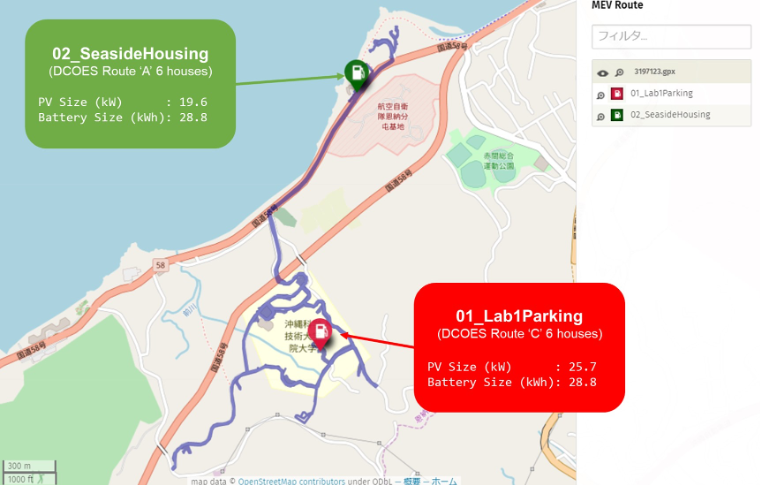

EV driving routes used for MIGEX simulation (left). Energy from the grid that is used to charge the EVs and would otherwise be wasted.
MIGEX for the Okinawan Islands
Under the OPG project, we also made investigations into the potential areas around Okinawa, which could benefit from installation of a MIGEX system. For that, we chose several islands with public institutions known to use solar panels to cover their power needs.
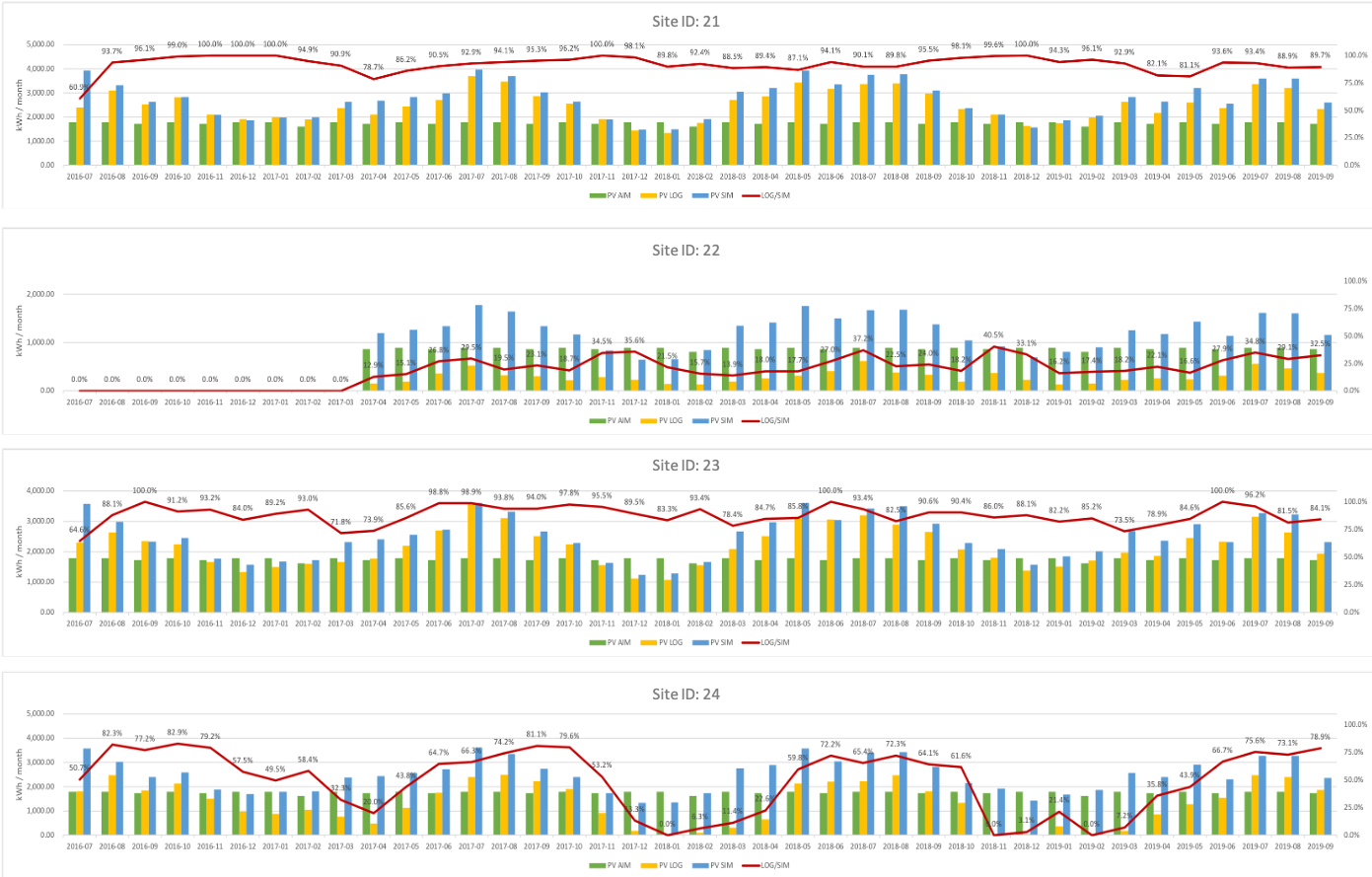
Monthly energy production (kWh/month) and energy usage (%) in the sites 21-24 of the remote island ID8.
It shows the amounts of monthly PV generation comparisons in the bar charts, where the amounts of the (green) target PV generation, the (yellow) actual PV generation, and the (blue) simulated potential PV generation. The (red) line chart shows the energy usage rate calculated by the actual PV generation/simulated potential PV generation.
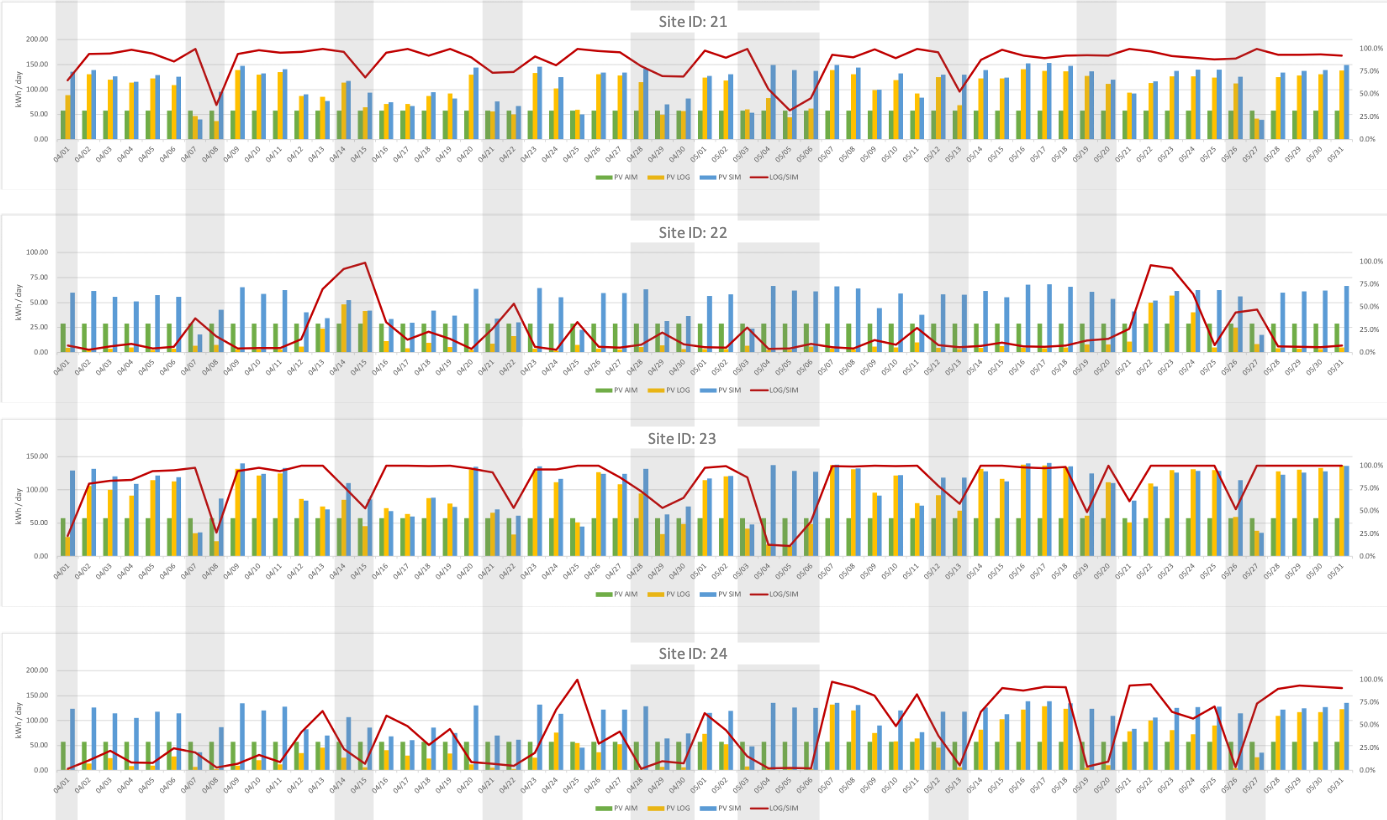
Daily energy production (kWh/day) and energy usage (%) in the site 21-24 of the remote island ID8 days between April 1 and May 31 in 2018.
It shows the amounts of monthly PV generation comparisons in the bar charts, where the amounts of the (green) target PV generation, the (yellow) actual PV generation, and the (blue) simulated potential PV generation. The (red) line chart shows the energy usage rate calculated by the actual PV generation/simulated potential PV generation.
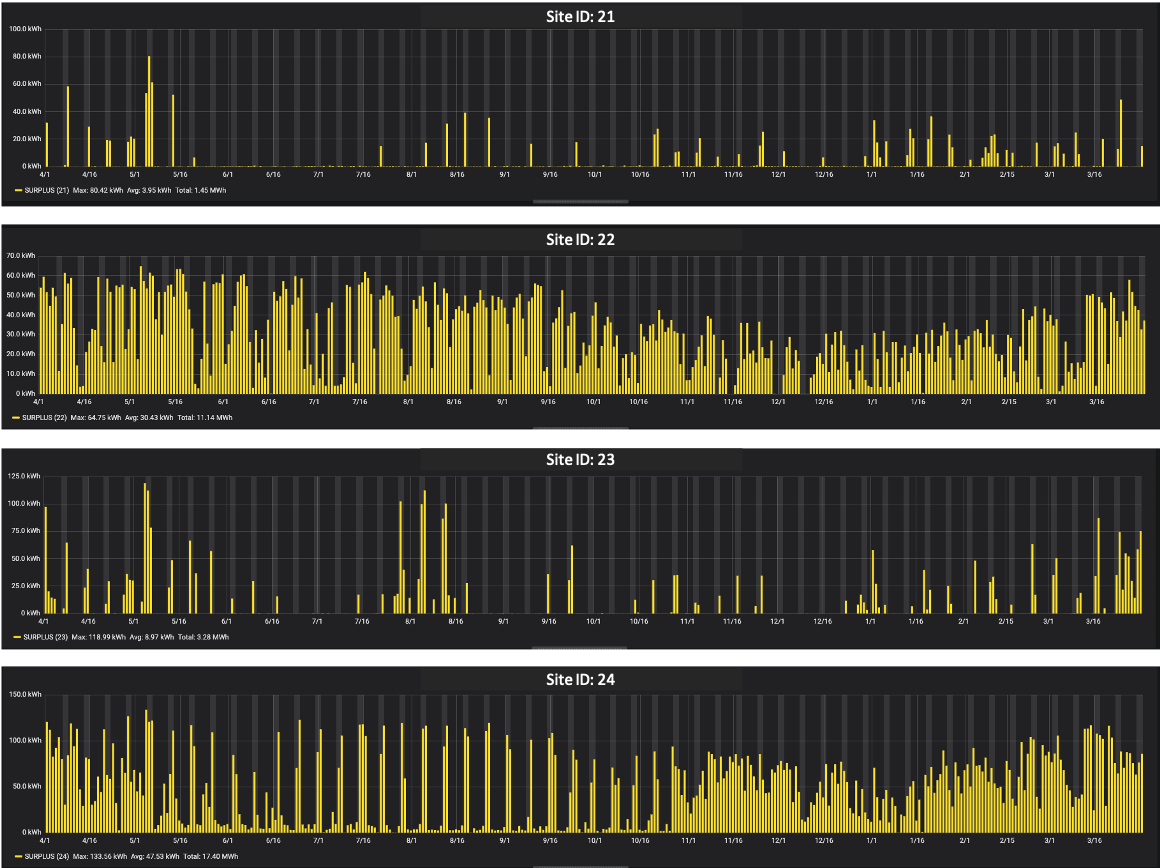
Daily surplus energy production for the year 2018 in the sites 21-24 of the remote island ID8
SLA Campus Tours and Presentations
- Tokyo Electric Power Company, Kansai Electric Company, Chubu Electric Company, Mitsui Electric Company, CRIEPI (16 visitors, April 12th)
- Onna-son junior high school students (June 26th, 8 visitors)
- Hitachi (August 12th, 8 visitors)
- Sansouken, Furukawa (August 19th, 7 visitors)
- Research Institute of Electric Power Industry, EDF (Nov 25, 4 visitors)
- Prof. Kazuhide Ito, Kyushu university, Prof. Jonathan Manton, Uni Melbourne (Dec 6th)
- Nissin Electric and Trans Engineering Partners (March 26th, 4 visitors)
3.3 Sustainable living in the Hot-Humid Region
FY2019 was focused on finalizing research on the cascade solar system and submitting the concept of sustainable architecture to the Good design awards with Misawa R&D as main representative.
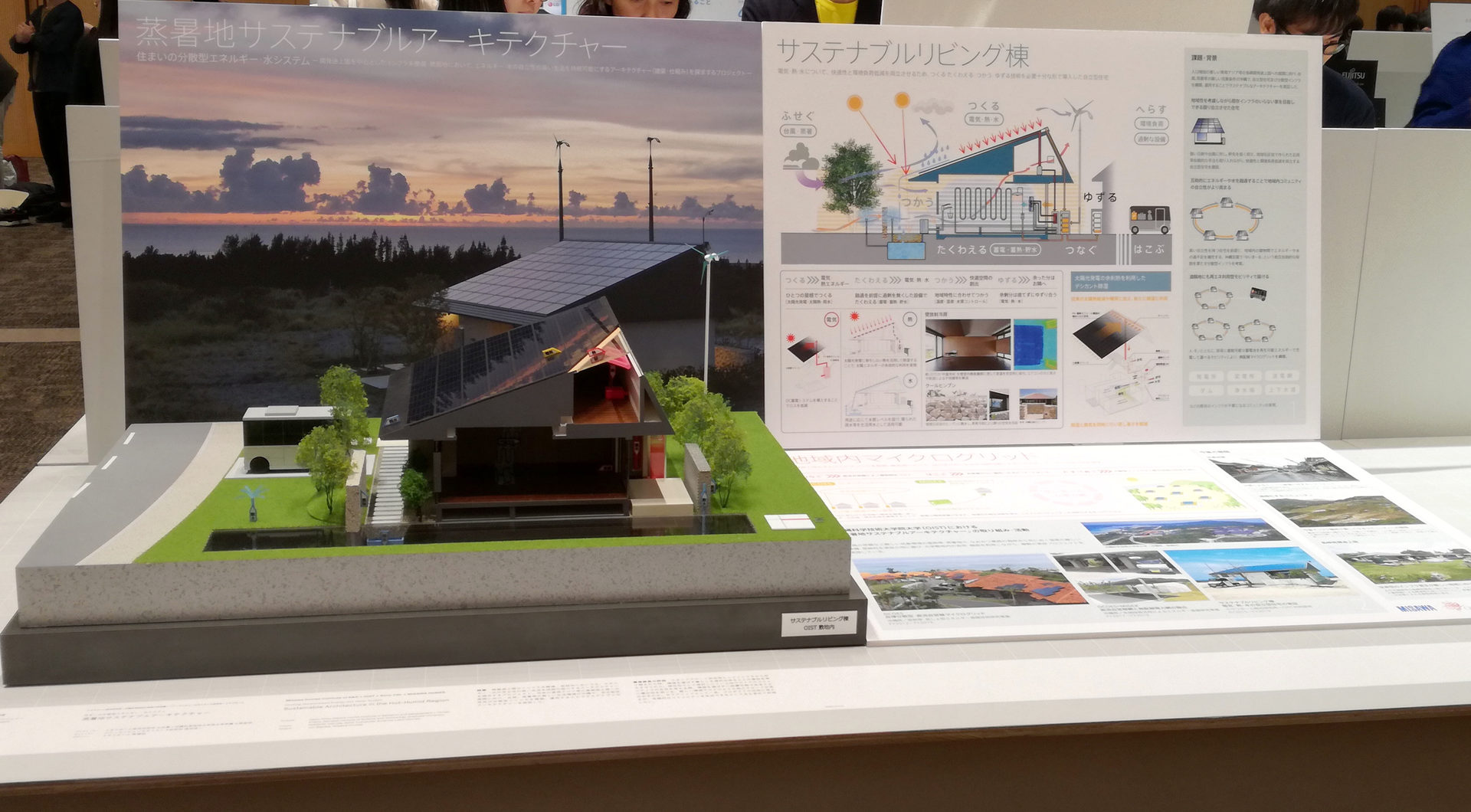
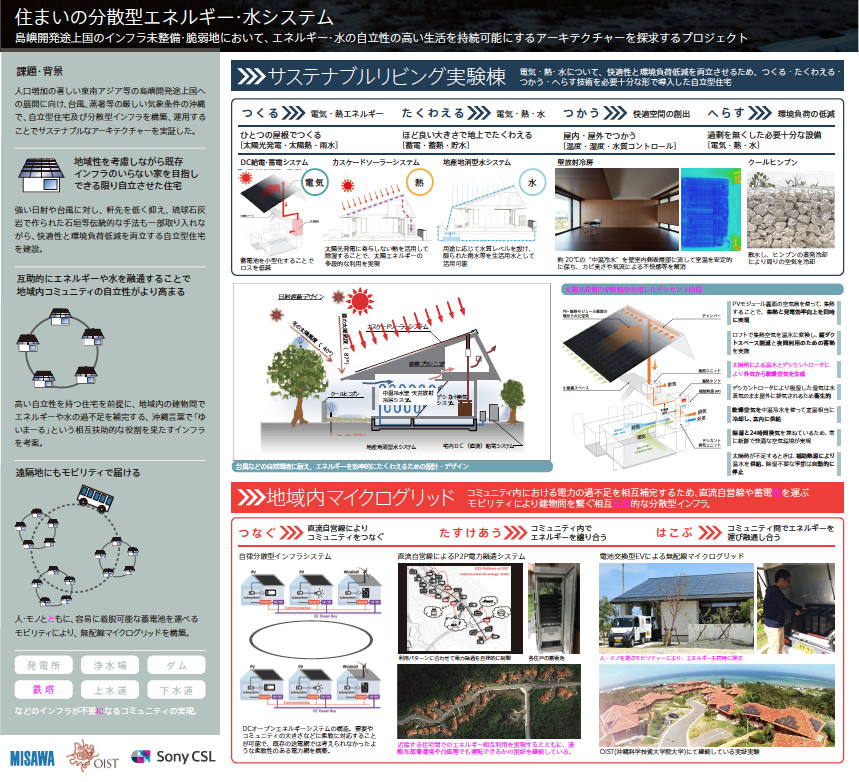
We are proud that this project was placed under the Best 100 and also received a Good Focus Award in the category of "Disaster Prevention and Recovery Design". Committee evaluation: "When homes are set free from infrastructure in the shape of stand-alone houses, it prompts us to think about the significance of being able to live anywhere regardless of the environment. When you think about living in places that are difficult to settle in or in micro-communities, the fact that it can be set up in any environment is an advantage. What is the probable construction timeline in a harsh environment? While it can just be seen as a series of off-the-grid products or houses, it is worthy to praise in its potential to generate organic communities as well".
3.5 Sensor System for Sustainable Smart Green Houses and Microbial Fuel Cells
Microbial Fuel Cells are complex microbiological systems that allow for waste water treatment. In collaboration with Goryanin Unit, we designed an intelligent sensor system customized for such fuel cells. To start with we implemented a new microchip board.
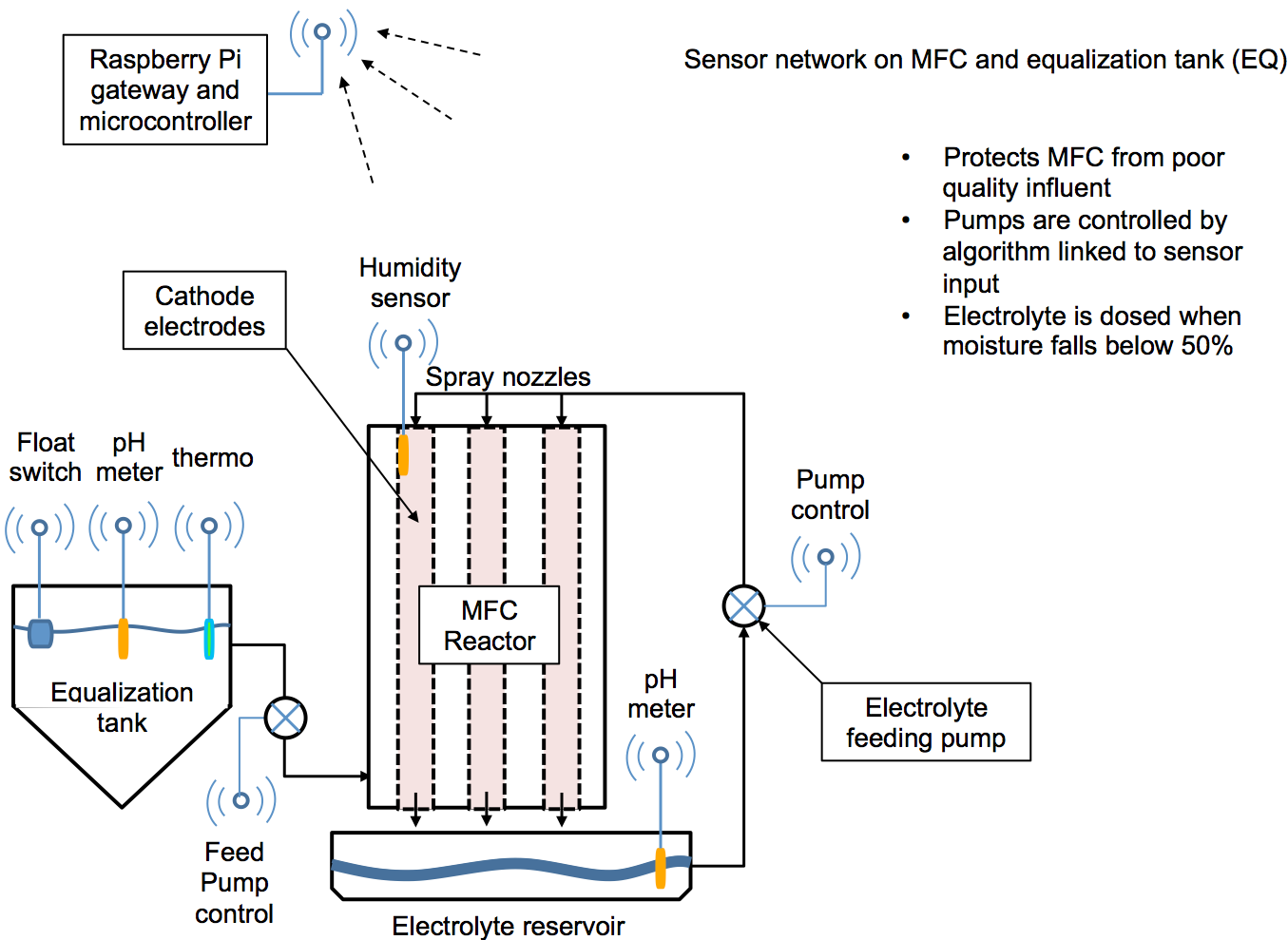
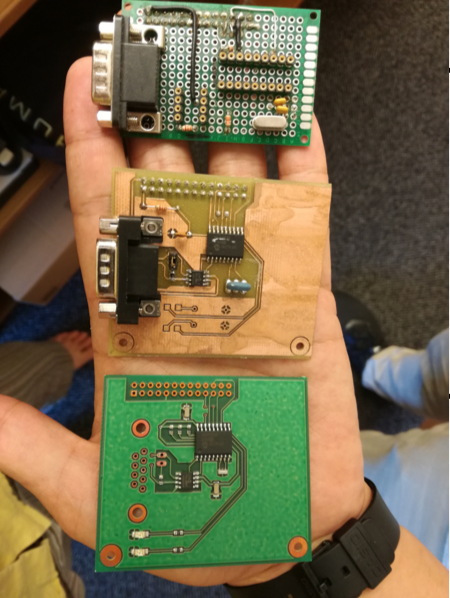
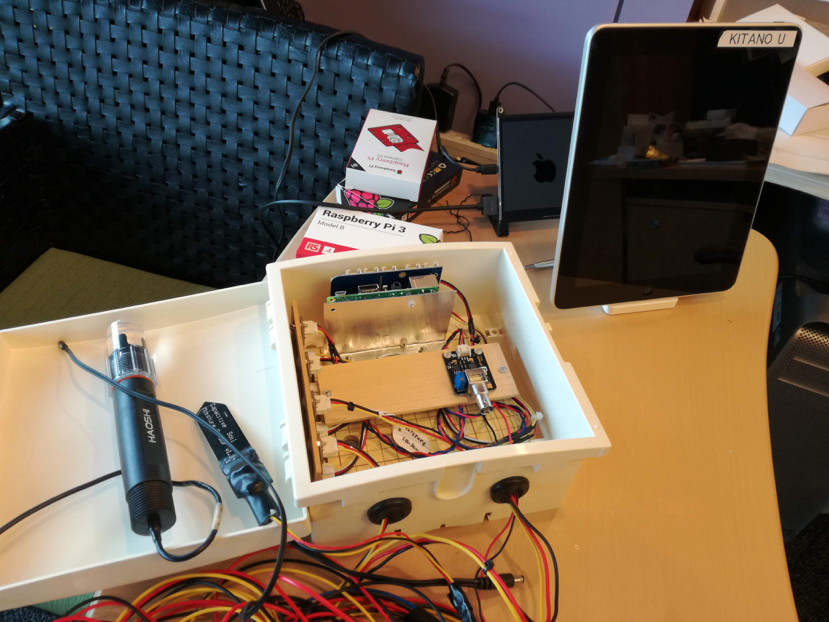
Figure xx: MFC sensor network, sensor microchip prototype, wired prototype
4. Publications
4.1 Journals
- Shuntaro Chiba, Masahito Ohue, Anastasiia Gryniukova, Petro Borysko, Sergey Zozulya, Nobuaki Yasuo, Ryunosuke Yoshino, Kazuyoshi Ikeda, Woong-Hee Shin, Daisuke Kihara, Mitsuo Iwadate, Hideaki Umeyama, Takaaki Ichikawa, Reiji Teramoto, Kun-Yi Hsin, Vipul Gupta, Hiroaki Kitano, Mika Sakamoto, Akiko Higuchi, Nobuaki Miura, Kei Yura, Masahiro Mochizuki, Chandrasekaran Ramakrishnan, A. Mary Thangakani, D. Velmurugan, M. Michael Gromiha, Itsuo Nakane, Nanako Uchida, Hayase Hakariya, Modong Tan, Hironori K. Nakamura, Shogo D. Suzuki, Tomoki Ito, Masahiro Kawatani, Kentaroh Kudoh, Sakurako Takashina, Kazuki Z. Yamamoto, Yoshitaka Moriwaki, Keita Oda, Daisuke Kobayashi, Tatsuya Okuno, Shintaro Minami, George Chikenji, Philip Prathipati, Chioko Nagao, Attayeb Mohsen, Mari Ito, Kenji Mizuguchi, Teruki Honma, Takashi Ishida, Takatsugu Hirokawa, Yutaka Akiyama & Masakazu Sekijima. A prospective compound screening contest identified broader inhibitors for Sirtuin 1. Scientific Reports, 9, Article number: 19585 (20 December 2019). doi:10.1038/s41598-019-55069-y, https://www.nature.com/articles/s41598-019-55069-y
- Vipul Gupta, Alina Crudu, Yukiko Matsuoka, Samik Ghosh, Roger Rozot, Xavier Marat, Sibylle Jäger, Hiroaki Kitano & Lionel Breton. Multi-dimensional computational pipeline for large-scale deep screening of compound effect assessment: an in silico case study on ageing-related compounds. npj Systems Biology and Applications, 5, Article number: 42 (26 November 2019), doi:10.1038/s41540-019-0119-y, https://www.nature.com/articles/s41540-019-0119-y
- Yukiko Matsuoka, Ayako Yachie, Hiroaki Kitano/松岡由希子, 谷内江綾子, 北野宏明. Kαmpo Systems Biology/システムバイオロジーで拓く新たな漢方医学研究. Progress in Medicine, November Issue 2019/2019年11月号, 39, 11, 1085-1090, Nov. 2019.
- N. N. Price, S. Muko, L. Legendre, R. Steneck, M. J. H. van Oppen, R. Albright, P. Ang Jr., R. C. Carpenter, A. P. Y. Chui, T.-Y. Fan, R. D. Gates, S. Harii, H. Kitano, H. Kurihara, S. Mitarai, J. L. Padilla-Gamiño, K. Sakai, G. Suzuki, P. J. Edmunds. Global biogeography of coral recruitment: tropical decline and subtropical increase. Marine Ecology Progress Series, 621, 1-17, July 4, 2019. https://doi.org/10.3354/meps12980, https://www.int-res.com/abstracts/meps/v621/p1-17/
4.2 Books and other one-time publications
Nothing to report
4.3 Oral and Poster Presentations
[Oral Presentations]
- Kitano, H. Artificial Intelligence to Win the Nobel Prize and Beyond: Creating the Engine for Scientific Discovery, AI for scientific discovery workshop, The Alan Turing Institute, 116 Pall Mall, London, Feb. 25, 2020. (invited)
- Hiroaki Kitano / 北野宏明.Nobel Turing Challenge: Creating the Engine for Scientific Discovery. /ノーベル・チューリングチャレンジ:科学的発見のエンジンを開発する. Japan Association for Omics-baced Medicine /日本オミックス医学会シンポジウム. Ochanomizu Igakukaikan / お茶の水医学会館, Tokyo / 東京, Feb 19, 2020(invited)
- Hiroaki Kitano / 北野宏明. Creating the Engine for Scientific Discovery: Nobel Turing Challenge as a grand challenge project in AI and Systems Biology. 講演会. Mitsubishi /三菱重工. Nagoya /名古屋, Feb 18, 2020 (invited)
- Hiroaki Kitano / 北野宏明. Distributed infrastructure management using AI / AIを用いた分散型インフラマネジメント. OIST-Hitachi joint symposium, Hitachi Central Research Laboratory, Kokubunji / 国分寺, Feb 17, 2020 (invited)
- Hiroaki Kitano / 北野宏明. Nobel Turing Challenge: Creating the Engine for Scientific Discovery. /ノーベル・チューリングチャレンジ:科学的発見のエンジンを開発する. NIBIO Kick-off symposium / 医薬基盤・健康・栄養研究所AI健康・医薬研究センターキックオフシンポジウム, Senri Life Science Center / 千里ライフサイエンスセンター山村雄一記念ライフホール, Osaka / 大阪, Feb. 3, 2020. (keynote)
- Hiroaki Kitano / 北野宏明. Artificial intelligence challenges the human cognitive limits /人間の認知限界に挑む人工知能. Japan Medical Association / 日本医師会医療情報システム協議会, JMA Building / 日本医師会館, Tokyo / 東京, Feb. 1, 2020.(invited)
- Hiroaki Kitano / 北野宏明. Nobel Turing Challenge: Creating the Engine for Scientific Discovery. /ノーベル・チューリングチャレンジ:科学的発見のエンジンを開発する. 2020 JMAI 2nd annual meeting /第二回日本メディカルAI学会学術集会, Tokyo Big Sight / 東京ビックサイト, Tokyo / 東京, Feb. 1, 2020. (keynote)
- Hiroaki Kitano /北野宏明. Artificial Intelligence to Win the Nobel Prize / 人工知能がノーベル賞を獲る日, Ochanomizu Univ. / お茶の水女子大学 生物学科セミナー, International Student Plaza / 国際交流プラザ多目的ホール, Tokyo / 東京, Jan 30, 2020. (invited)
- Hiroaki Kitano / 北野宏明. Nobel Turing Challenge: Creating the Engine for Scientific Discovery. /ノーベル・チューリングチャレンジ:科学的発見のエンジンを開発する. Esai Data Science Advisory Board Meeting / エーザイ データサイエンスアドバイザリーボードミーティング. Ezai Tsukuba Lab / エーザイ筑波研究所. Ibaraki /茨城, Jan 29, 2020.(invited)
- Hiroaki Kitano / 北野宏明. Nobel Turing Challenge: Creating the Engine for Scientific Discovery. ノーベル・チューリングチャレンジ:科学的発見のエンジンを開発する.Nagoya Univ. / 名古屋大学講演会, National Innovation Complex / 名古屋大学ナショナルイノベーションコンプレックス, Dec. 23, 2019. (invited)
- Kitano,H. Areas and Vision for Setting Moonshot Goals . Moonshot International Symposium, Bellesalle Tokyo Nihonbashi, Tokyo, Dec. 17, 2019. (invited)
- Hiroaki Kitano / 北野宏明. AI strategy and moonshot in Japan /日本のAI戦略とムーンショット・プログラム:その意図、課題と今後の展開,JSAI Workshop 2019/ 人工知能学会合同研究会2019, Keio Uni. / 慶應義塾大学矢上キャンパス, Kanagawa / 神奈川, Nov. 22, 2019. (invited)
- Hiroaki Kitano / 北野宏明. Nobel Turing Challenge: Creating the Engine for Scientific Discovery / ノーベル・チューリング・チャレンジ ~2050年までにノーベル賞を受賞するAIが出現する. GHELIA EXPO TOKYO 2020, Hamamatsucho Convention Hall/浜松町コンベンションホール, Tokyo/東京, Nov. 21, 2019.(invited)
- Kitano, H. Nobel Turing Challenge: Creating the Engine for Scientific Discovery. ICSB 2019, OIST, Okinawa, Nov. 5, 2019. (keynote)
- Hiroaki Kitano/ 北野宏明, Cutting edge of AI technology and impact of social industry/人工知能技術の最先端と社会産業のインパクト, Seminar for Financial Services Agency / 金融庁にて講演, Financial Services Agency / 金融庁, Oct. 25, 2019/ 2019年10月25日(invited)
- Hiroaki Kitano/ 北野宏明, Cutting edge of AI technology and Moonshot in the context of Society 5.0/AIの最先端とSociety5.0の文脈におけるムーンショット, Seminar for the members of Japan Association of Corporate Executives / 経済同友会会員セミナー, Dai-Ichi Hotel Tokyo / 第一ホテル東京, Oct. 9, 2019 / 2019年10月9日(invited)
- Hiroaki Kitano/ 北野宏明, AI for BioMedical Sciences / AI駆動型生命科学, Bio Japan 2019 / バイオジャパン2019, Pacifico Yokohama / パシフィコ横浜,Oct. 9, 2019 /2019年10月9日(keynote)
- Hiroaki Kitano,Key Messages from Concurrent Sessions, STS forum, the Kyoto International Conference Center, Kyoto, Oct. 8, 2019. (invited)
- Hiroaki Kitano/ 北野宏明. Nobel Turing Challenge: Creating the Engine for Scientific Discovery.ノーベル・チューリングチャレンジ:科学的発見のエンジンを開発する, training sessions for the board members of Seiko Epson / セイコーエプソン社役員研修会, Seiko Epson Corporation / セイコーエプソン社本店, Oct. 2, 2019 / 2019年10月2日(invited)
- Kitano, H. Nobel Turing Challenge: Creating the Engine for Scientific Discovery. Nature conference on AI & Robotics, Tencent Binhai Towers, Shenzhen, China, Sep. 2, 2019.
- Kitano, H. Nobel Turing Challenge: Creating the Engine for Scientific Discovery. PRICAI 2019, Shangri-La's Fijian Resort & Spa, Yanuca Island, Cuvu, Fiji, Aug. 28, 2019.(keynote)
- Kitano, H. Creating the Engine for Scientific Discovery: Nobel Turing Challenge as a new Moonshot project in AI and Systems Biology. IJCAI-19, The Venetian Macao Resort Hotel, Macao, China, Aug. 16, 2019.
- Hiroaki Kitano/北野宏明. Nobel Turing Challenge: Creating the Engine for Scientific Discovery/ノーベル・チューリングチャレンジ:科学的発見のエンジンを開発する. “Correspondence and Fusion of Artificial Intelligence and Brain Science” Summer School 2019 for Young Researchers/新学術領域研究「人工知能と脳科学の対照と融合」若手サマースクール, RIKEN Brain Science Institute, Saitamta/理化学研究所脳科学総合研究センター, 埼玉, Aug. 2, 2019.
- Hiroaki Kitano/北野宏明. Creating the Engine for Scientific Discovery: Nobel Turing Challenge as a grand challenge project in AI and Systems Biology/科学的発見のエンジンを開発する:AIとシステムバイオロジーのグランドチャレンジとしてのノーベル・チューリングチャレンジ. PRISM “Development of Artificial Intelligence to Accelerate the Creation of New Drugs” FY2018 Results Report Meeting/PRISM「新薬創出を加速する人工知能の開発」2018年度成果報告会, National Cancer Center Research Institute, Tokyo/国立がん研究センター研究所, 東京, July 17, 2019.
- Hiroaki Kitano/北野宏明. Creating the Engine for Scientific Discovery: Nobel Turing Challenge as a grand challenge project in AI and Systems Biology/科学的発見のエンジンを開発する:AIとシステムバイオロジーのグランドチャレンジとしてのノーベル・チューリングチャレンジ. Blockbuster TOKYO Training Seminar/Blockbuster TOKYO研修セミナー, Nihonbashi Life Science Hub, Tokyo/日本橋ライフサイエンスハブ, 東京, July 17, 2019.
- Hiroaki Kitano/北野宏明. Japanese AI Strategy and Future of Systems BioMedicine/日本のAI戦略と変貌するシステム医科学の将来. The 3rd Symposium “New Challenge to Refractory Disease by Artificial Intelligence and System Medicine”/第3回シンポジウム「人工知能・システム医学による難治性疾患への新たな挑戦」, Kogushi Campus, Yamaguchi University, Yamaguchi/山口大学小串キャンパス,山口, June 22, 2019.
- Kitano, H. Nobel Turing Challenge for Creating the Engine of Scientific Discovery: Moonshot of AI, Robotics, and Systems Biology. SciLifeLab Science Summit 2019, Uppsala Concert & Congress, Uppsala, Sweden, May 15, 2019.
- Kitano, H. Garuda Connectivity Platform and Gandhara AI Framework for Life Science. NBIS/SciLifeLab Workshop, BMC, Uppsala Biomedical Centre, Uppsala, Sweden, May 14, 2019.
5. Intellectual Property Rights and Other Specific Achievements
Nothing to report
6. Meetings and Events
6.1 Seminar: Modular Deep Reinforcement Learning from Reward and Punishment for Robot Naviagation
- Date: June1 17th 2019
- Venue: Lab1 C015
- Speakers:
- Jiexin Wang (Advanced Telecommunications Research Center, Kyoto, Japan)
7. Other
Nothing to report.



